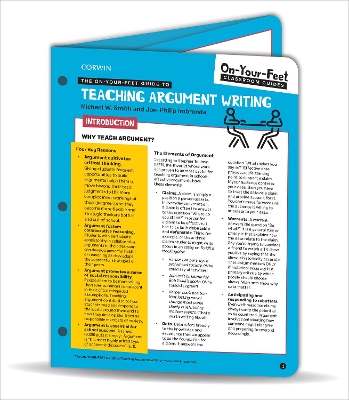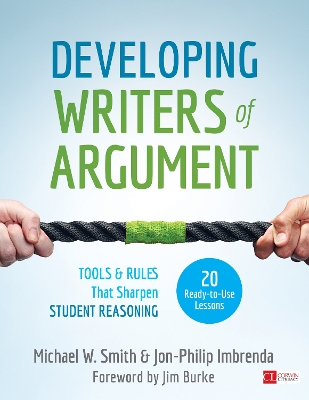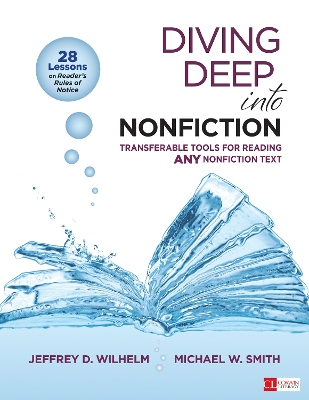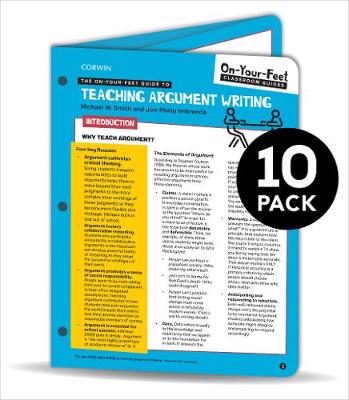Corwin Literacy
4 total works
The On-Your-Feet Guide to Teaching Argument Writing
by Michael W Smith and Jon-Philip Imbrenda
All On-Your-Feet Guide orders receive FREE SHIPPING! Use code SHIPOYFG at check out.
In this brief but comprehensive guide to teaching argument writing, teachers will learn why teaching argument is important, the elements of formal argument, and how to get started with their own students in sections that include planning, assessing, and troubleshooting. Also provided: a semantic differential scale, scenario, and language frames to help jumpstart your first lesson.
From this guide, teachers will receive:
- tools for assessment
- an If-Then chart that helps teachers troubleshoot common problems
- coaching to use Toulmin prompts to elicit the elements of argument from students.
On-Your-Feet Guides (OYFGs) provide you with the ultimate "cheat sheet" to implement effective change in your classroom while in the moment of teaching. Designed for accessibility, and providing step-by-step guidance, the OYFGs are written by experts who take research-based practices and make them doable for the busy teacher.
Each On-Your-Feet Guide is laminated, 8.5"x11" tri-fold (6 pages), and 3-hole punched.
Use the On-Your-Feet Guides
* When you know the "what" but need help with the "how"
* As a quick reference to support a practice you learned in a PD workshop or book
* To learn how to implement foundational practices
* When you want to help your students learn a specific strategy, routine, or approach, but aren't sure how to do it yourself
Developing Writers of Argument
by Michael W Smith and Jon-Philip Imbrenda
Diving Deep Into Nonfiction, Grades 6-12
by Jeffrey D Wilhelm and Michael W Smith
BUNDLE: Smith: The On-Your-Feet Guide to Argument: 10 Pack
by Michael W Smith and Jon-Philip Imbrenda
All On-Your-Feet Guide orders receive FREE SHIPPING! Use code SHIPOYFG at check out.
In this brief but comprehensive guide to teaching argument writing, teachers will learn why teaching argument is important, the elements of formal argument, and how to get started with their own students in sections that include planning, assessing, and troubleshooting. Also provided: a semantic differential scale, scenario, and language frames to help jumpstart your first lesson.
From this guide, teachers will receive:
- tools for assessment
- an If-Then chart that helps teachers troubleshoot common problems
- coaching to use Toulmin prompts to elicit the elements of argument from students.
On-Your-Feet Guides (OYFGs) provide you with the ultimate "cheat sheet" to implement effective change in your classroom while in the moment of teaching. Designed for accessibility, and providing step-by-step guidance, the OYFGs are written by experts who take research-based practices and make them doable for the busy teacher.
Each On-Your-Feet Guide is laminated, 8.5"x11" tri-fold (6 pages), and 3-hole punched.
Use the On-Your-Feet Guides
* When you know the "what" but need help with the "how"
* As a quick reference to support a practice you learned in a PD workshop or book
* To learn how to implement foundational practices
* When you want to help your students learn a specific strategy, routine, or approach, but aren't sure how to do it yourself



